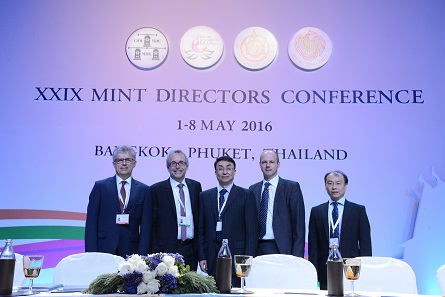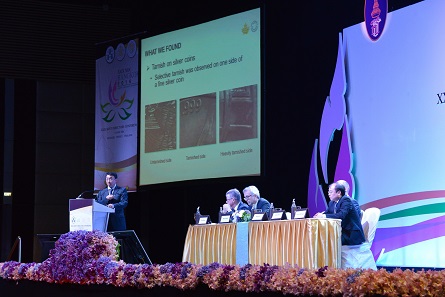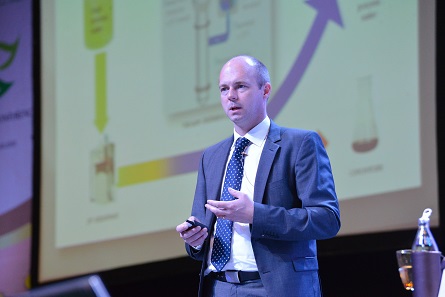by Ursula Kampmann
translated by Annika Backe
June 23, 2016 – From May 1 to 4, 2016, the Mint Directors Conference took place in Bangkok. It was attended by nearly 360 delegates for whom 35 presentations were held. Here you find an abstract of the papers given by the Technical Committee.
The attendees of the “Optimum Conditions” session, from left to right: Dr Peter Huber, Dieter Merkle, Dr Xianyao Li, Ingo Löken, and Koichi Shirasaka. Photograph: Mint of Thailand.
Optimum Conditions
Dr Peter Huber of the State Mints of Baden-Wuerttemberg hosted the session that focused on “Optimum Conditions”.
Dieter Merkle / Schuler Pressen GmbH, Back to the Future – Quality Assurance for Circulation Coins
The Technical Committee of the MDC will publish a guideline for quality assurance for circulation coins in the last quarter of 2016.
To this end, two questionnaires were carried out. They determined the key features to assess quality. These include, for example, the weight, the diameter, the relief height, the layer thickness of the plating, and so forth. The new guideline will specify in great detail the exact meaning of these terms. It will propose tolerances and test methods.
The guideline for quality assurance will make it easier to put out comparable tenders and ensure that both contracting partners mean the very same thing. The guideline will be available only to state mints and their suppliers. Even after transfer, the book will remain to be the property of the Technical Committee of the MDC and may be disclosed to third parties only with written permission.
Dr Xianyao talks about how unpleasant discolorations on modern coins can be prevented. Photograph: Mint of Thailand.
Dr Xianyao Li / Royal Canadian Mint, Guideline for Tarnish & Surface Protection of Coins
While in Classical numismatics, a beautiful patina increases a purchase price, in contemporary numismatics everything is done to prevent discolorations of this kind. For this end, the Technical Committee set up a subcommittee specifically for dealing with this issue. Dr Xianyao Li presented first intermediate results.
In the first step, the study analyzed the tarnish discoloration on silver. It turned out that contributing to the discoloration were sulfur, phosphorus, chlorine, potassium, sodium, calcium, as well as iron and magnesium, which had been added to the surface from the outside.
The committee is also currently working on tests to assess the chemical stability of the coins’ surface. These tests were conducted on silver coins in capsules as well as on lacquered and unlacquered coins. The observation was that capsules generally protect no matter if these capsules were threaded or sealed. Lacquered coins exhibited considerably less tarnishing than coins in capsules.
Currently, there is a wide variety of lacquers and coatings in use: acrylic based lacquer, passive oxide coating, E-coating, PVD coating, CVD coating, ALD coating. Some methods have been examined for their effectiveness. The Shenzhen Mint, for instance, found out that passive oxide coating can effectively protect coins from white spots as a result of a reaction between the silver and the chlorine. The Austrian Mint examined different coatings. When applied unevenly, CVD coating can produce a rainbow patina. PVD can have shadow effects. ALD coating obtained convincing test results because the thickness of the coating is easy to control. The processing time, however, is too long.
The studies will be continued and additional test methods will be tested.
Ingo Löken presented the latest findings of the subcommittee “Environment Best Practice”. Photograph: Mint of Thailand.
Ingo Löken / Spaleck Oberflächentechnik, Environmental Best Practice
Strictly speaking, the question asked by the subcommittee “Environment Best Practice” is a rather simple one: How many cubic meters of water are currently needed to produce one ton of coining blanks? 19 companies participated in the study, 9 of which are accredited according to ISO 14001, and 10 are accredited according to ISO 9001.
It can be summarized that, at present, the mentioned question cannot be answered. Because of the inconsistency of the data it is not possible to perform a calculation.
Nevertheless, there are results: For example, sulfuric acid is still being used, but with thorough inspection of the waste water.
Water consumption is an issue, and some mints conduct training on this subject. There are, on the other hand, big differences in the number of parameters and limits to inspect the waste water. Only a single participant has a regulation of the maximum amount of water to use. Nobody has an in-house restriction of the maximum amount of water to use.
Most companies handle their waste water chemically/physically, without recycling.
First recommendations were made, including a review of whether or not the use of sulfuric acid is still state of the art. In addition, it was said that the installation of a measurement system for fresh and waste water is useful because you can only improve what you measure. As a general rule, it would be much better for the environment to not consume water but to recycle it.
Finally, the committee suggested the institution of an MDC Prize, to reward companies for their careful use of resources.
Koichi Shirasaka / Japan Mint, Application of Finite Element Method for Coining Process
The Finite Element Method facilitates the calculation of the pressure applied in the coining process, through breaking down the coin relief into a large number of partial bodies in a simple form (hence finite elements).
The Japan Mint uses this method to resolve problems concerning the coining die life. Initial results were presented already at the 2014 MDC. In the meantime, a new software version has been released, which allows the analysis of surface structures that are even more complex.
The Japan Mint used it to examine the 100 yen circulation coin as well as the 100 yen commemorative coin and made test strikings with dies that had been modified after the FEM analysis.
A modification of the relief made it possible to increase the die life significantly. Even with a mere 80% reduction of the relief height, the die life increased by a factor of 1.5, with a 70% reduction this factor was 2.4, and with a 60% reduction it was 2.5.
The Japan Mint currently intends to implement this method already during the planning stage of the coin design, so as to eliminate problems in the minting process.
In the upcoming part of the abstract of the papers given at the MDC we will focus on the presentations of the Marketing Committee.
Please find a general contribution on the Mint Directors Conference here.
Part 1 with an abstract of the presentations of “The plenary sessions” can be found here. Part 2 containing the first part of the presentations of the Technical Committee can be found here.
And the website of the MDC 2016 in Bangkok can be accessed here.







